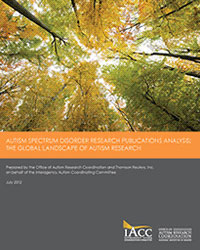Publications Analysis
Autism Spectrum Disorder Research
The Global Landscape of Autism Research
2012
Chapter One: Trends in Autism Research Topics and Publications
As discussed in the introduction, there are many aspects of autism in need of more research. The research topics of highest priority to the IACC are those set forth in the seven chapters/Critical Questions of the IACC Strategic Plan (described in Figure 1). To describe the nature of research being published in autism, publications were classified by how they best aligned with the IACC Strategic Plan. First, all 2010 publications were categorized manually into one of the seven Critical Question areas outlined in the Strategic Plan. Read more.
Spotlight On Risk Factor Research
With 1 in 88 children affected by autism, the patient and research communities feel a sense of urgency to identify risk factors that may be contributing to the rise in autism prevalence. Autism risk factor research has yielded some strong leads, but much work remains to identify a more complete picture of the risk factors that play the most significant role in the development of autism. Scientific evidence suggests that genetic and environmental risk factors form a complex web of interactions that determine whether a person develops an autism spectrum disorder. Read more.
Spotlight On Treatments And Interventions Research
Treatments and Interventions research is one of the highest priority areas for people with autism and their families, as the development of effective treatments and interventions has the potential to reduce disability and significantly enhance quality of life. A wide variety of autism treatment and intervention approaches exist that are designed to reduce disabling symptoms and increase functional skills and abilities, and there is a growing body of research to support the use of particular treatment and intervention approaches. Even so, there is pressing need for a stronger evidence-base across the range of intervention options that are actively used in the home and community. Read more.
Chapter Two: Impact and Maturity Of The Autism Research Field
While the annual numbers of ASD-related publications have grown since 1980, the quality of this research and the maturity of the field remain open questions. The following sections try to address these questions through a variety of measures. The "quality" of a research publication is a qualitative assessment that depends on underlying assumptions and values. This analysis focuses instead on several quantitative measures that can provide a more objective assessment of the published research. Read more.
Chapter Three: Global Autism Research Funders
The 2010 IACC Autism Spectrum Disorder Research Portfolio Analysis Report tracks US public and private autism research funding, or inputs, as shown in Figure 2.19 This chapter of the ASD Publications Analysis complements the IACC Portfolio Analysis by providing an examination of the publication activity of US and non-US funders to determine which have made significant contributions to published research, or research outputs. Acknowledged funders were identified to reveal prominent funding bodies in the autism research arena. Read more.
Chapter Four: Global Autism Publications and Collaborations
This chapter highlights where autism research is taking place and identifies key trends, including which countries are increasing their share of autism global output, the extent of collaboration between authors in different countries and different research institutions, and whether collaborative research results in higher impact autism publications. To determine the geographic locations of autism-related research activities, the Web of Science® author address field was used to identify the research institution, country, and US state for each author on a given publication within the ASD publication set. Publications with multiple authors were therefore attributed to multiple addresses. Read more.
The goal of this broad, preliminary analysis of ASD research publication data was to examine the development and current state of autism science to inform the strategic planning efforts of the Interagency Autism Coordinating Committee (IACC) and to help various stakeholders gain insight into the possible impacts and implications of ASD research activities and investments. Publications serve as a primary output of research efforts, and an in-depth understanding of autism publication trends can help research funders, policymakers, researchers and other community stakeholders design strategies to maximize progress and cultivate breakthrough research. Read more.




